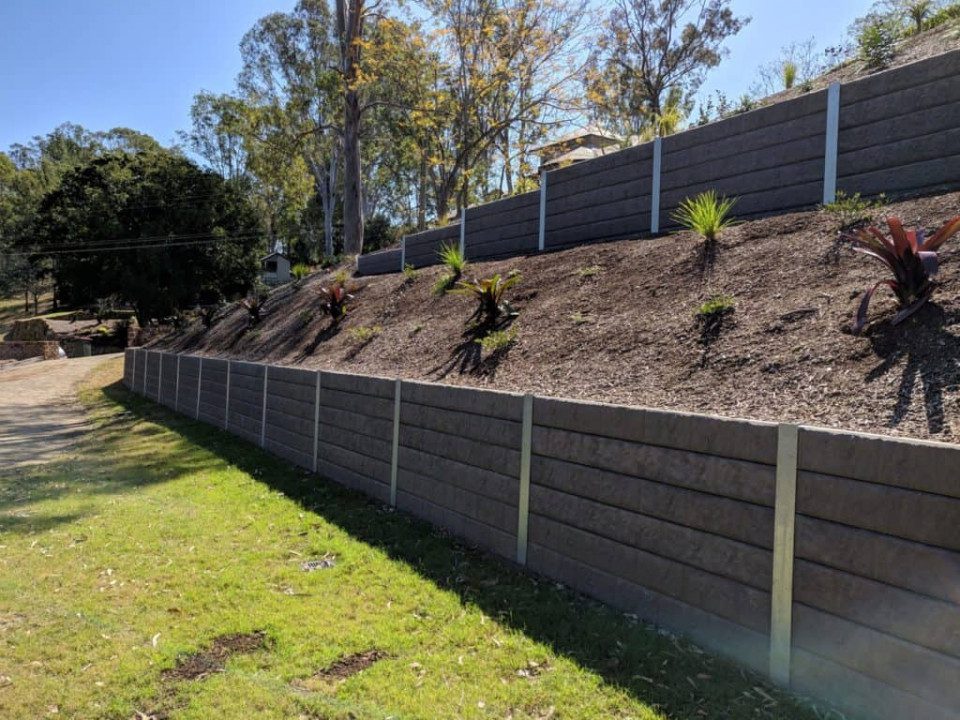Guaranteeing Structural Stability: The Value of Correctly Created Maintaining Walls in Avoiding Slope Failure
In the world of civil engineering and building and construction, the relevance of correctly created maintaining wall surfaces in avoiding incline failure can not be understated. By discovering the complex interplay in between these elements, a much deeper comprehension of the essential duty that maintaining wall surfaces play in protecting architectural stability and avoiding incline failure arises.
Duty of Retaining Walls in Security
The indispensability of preserving wall surfaces in ensuring slope security is critical in civil engineering techniques. Keeping wall surfaces serve an important function in avoiding dirt erosion, handling water drainage, and maintaining the structural stability of inclines. By supporting near-vertical or upright quality changes, keeping wall surfaces help to redistribute side stress exerted by the soil, thereby decreasing the threat of incline failing.
One key feature of retaining walls is to combat the pressure of gravity acting upon the dirt mass behind them. This is achieved with proper style and building, which considers elements such as soil type, wall surface elevation, water drainage stipulations, and possible surcharge loads. By effectively maintaining soil within defined boundaries, these structures aid to maintain inclines and avoid landslides.
Furthermore, preserving wall surfaces add to the aesthetic appeals of landscapes while supplying useful benefits. They can create terraced degrees for landscaping, assistance streets or frameworks on hillsides, and enhance the total use of sloped surface. Essentially, retaining wall surfaces play a vital duty in keeping slope security and ensuring the security and durability of civil design projects.
Aspects Affecting Wall Surface Efficiency
Aspects that affect the performance of retaining walls include dirt buildings, wall design, and exterior loads. Proper wall style thinks about aspects like wall surface height, wall type (e.g., gravity walls, cantilever walls), reinforcement materials, drainage systems, and building methods to make sure the wall surface can stand up to the side pressure applied by the maintained dirt. By considering these factors thoroughly, engineers can construct retaining wall surfaces that effectively prevent slope failure and guarantee long-lasting structural integrity.
Design Factors To Consider for Maintaining Wall Surfaces
Integrating the vital aspects of soil homes and outside lots right into the architectural layout process is vital for creating effective keeping walls that make certain incline stability. When making preserving wall surfaces, engineers have to meticulously examine the qualities of the surrounding dirt, including its drain, compaction, and kind properties. Understanding these dirt residential or commercial properties is crucial for establishing the suitable wall surface elevation, reinforcement, and density needed to hold up against the lateral stress applied by the dirt mass.
Moreover, outside lots such as surcharge tons from neighboring structures or traffic, in addition to seismic pressures, need to be taken into consideration throughout the design phase. These tons can significantly impact the stability and performance of a preserving wall, requiring using appropriate style techniques and materials to reduce possible failing risks.
Furthermore, the choice of ideal products, such as concrete, stone, or wood, must straighten with the aesthetic needs and site-specific conditions. Factor of security considerations, drain stipulations, and building techniques are also important facets that influence the general design and functionality of keeping walls in avoiding slope failure. By meticulously considering these design considerations, engineers can ensure the architectural integrity and long-lasting stability of keeping walls.

Building Best Practices for Sturdiness
When building preserving wall surfaces for optimal longevity and long life, adherence to industry-standard methods and meticulous interest to detail are extremely important. To make sure the resilience of a preserving wall, correct site prep work is vital.
Integrating reinforcement techniques, such as geogrids or steel bars, can improve the structural stability of the maintaining wall and avoid prospective failures. By following these building best practices, retaining wall surfaces can hold up against the examination of time and properly protect against slope failure.
Importance of Proper Upkeep
Normal upkeep is look at more info necessary for maintaining the structural integrity and functionality of preserving wall surfaces in time. Overlooking upkeep can cause issues such as erosion, cracks, and even complete failing of the wall, jeopardizing the security of the incline it supports. To ensure that keeping wall surfaces remain to perform their designated function successfully, routine evaluations should be performed to determine any kind of indicators of wear and tear. These inspections can help in detecting very early caution signs of prospective issues, enabling prompt repairs to be performed prior to the problems intensify (Retaining Walls Sunshine Coast).

Final Thought
Finally, retaining walls play a vital duty in making certain architectural honesty and protecting against incline failing. By taking into consideration factors influencing wall performance, sticking to create considerations, following construction ideal techniques, and applying correct upkeep, the resilience of maintaining walls description can be made best use of. Retaining Walls Sunshine Coast. It is vital to identify the relevance of appropriately built preserving wall surfaces in check out this site preserving security and protecting against potential hazards connected with slope failing
Factors that influence the performance of preserving wall surfaces include soil residential or commercial properties, wall layout, and outside loads. Correct wall surface design thinks about variables like wall height, wall kind (e.g., gravity wall surfaces, cantilever walls), reinforcement products, drain systems, and construction strategies to make sure the wall can endure the side stress exerted by the preserved soil. By taking into consideration these variables thoroughly, designers can build preserving walls that properly stop slope failing and make sure long-term structural honesty.
Maintenance jobs might include getting rid of water drainage systems to stop water buildup behind the wall, fixing any visible fractures or damage, and making sure that the wall surface is totally free from plant life that could put in stress on the framework. By taking into consideration variables influencing wall efficiency, sticking to design considerations, adhering to construction finest techniques, and implementing proper maintenance, the durability of keeping wall surfaces can be optimized.